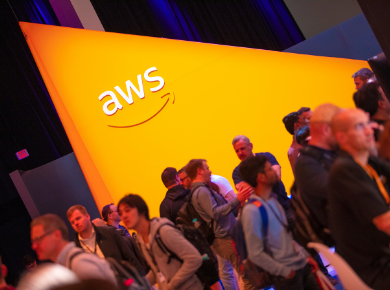A look inside: Our conversations with AWS customers
Feb. 5, 2020 | By: Mike Driscoll

In the global infrastructure footprint, only 3% of the addressable market has migrated to the cloud. That leaves 97% of the global infrastructure remaining on-premises. If that is any indication, we’ve had continuous conversations with our partners and customers around business modernization frameworks, as it tends to apply in so many different ways for every customer. There’s an excitement, but also a concern regarding what’s to come because the pace of human and technological change has left us all struggling to understand the value to seek and capture in the digital revolution.
How to approach business transformation
Customers often ask us how to transform—they may know what they want to transform, but they may not know a model of operating in a modern capacity in the cloud. There are two very real-world scenarios that tend to apply to the vast majority of our customers’ concerns. One of them may be trying to solve that operational piece, while the other may be looking at automation. How do you automate environments or how do you free up time to innovate and do things differently?
Both of these scenarios dovetail into the struggle of having legacy systems and modern systems and not knowing how to operate differently. Instead, oftentimes customers are operating like it’s 1970 but with a mix of new and old systems. The struggle is understanding how to operate differently considering the diversity in their portfolio, and the solution is a business modernization framework and building an operating model that works for new microservice architectures as well as the old monolithic domains, and showing a path how to move from one to the other.
Obviously, we’ve had conversations take different angles with customers in different industries. For example, security, threat and vulnerability detection are emphasized in high-tech companies who don’t want to be exposed—there’s a lot of hyperfocus on secure workloads in the cloud and validating those workloads, which requires a well-architected capability.
How to embrace change to prepare for future innovation
There are a few things that are really essential for an organization to be ready to move forward in terms of business modernization or cloud modernization. As mentioned in Andy Jassy’s keynote at AWS re:Invent 2019 , you need to have leadership commitment from the top down. But just as importantly—the organization has to embrace change and own it in a literal way. You have to be part of that change. And while getting lock-step with a partner is critical, being involved in the partnership and learning along the way is also necessary. There’s a huge opportunity for organizations to evolve and learn from their partners and be part of that transformation so that when they’re through it, there’s not a large exchange of information and knowledge—it’s a subtle transition that stems from self-sufficiency and natural growth.
Organizations need to commit teams of people that are willing to learn and apply new things because their jobs will specialize and change. For example, an IT infrastructure director’s team may have to learn some command line interface work that isn’t just graphical user interface (GUI)-based. And if they can wrap their head around doing command line interface work, they’ll be ready to change and adopt new capabilities to be world-class and close the gap.
How to face and overcome inertia
Start small but fast. Many organizations seem to find an idea and prove it out one way or another, leveraging a use case mentality. It’s been very effective with our customers in the past few years to prove a single concept and open additional opportunities as a result of organizational change. Of course, it takes several months to plan a transformation of scale, but it can simply take days, even hours, to build a proof of concept and begin innovating in discreet, small ways.
How to leave legacy systems behind
Two words: database freedom. There’s a strong need in the market to liberate our customers from legacy agreements as it relates to licenses and services. We have a robust and growing partnership with AWS, and a deep understanding going to market and initiating database freedom that’s intended to provide new capabilities, unlock potential and save money for organizations.
We experience many conversations where customers join feeling concerned and leave with clarity and pragmatism as a result of understanding that transformation is not some big, serial novel that needs to be read and absorbed by an individual. It breaks down to some simple things that can become actionable, broader, deeper and more applicable.
Mike Driscoll has been advising customers on technology transformation for more than 25 years. He started his career at Ernst & Young and transitioned to Slalom Consulting in 2011. After 16+ years at E&Y/Capgemini, and nearly eight years at Slalom, Mike has shifted his focus to building a world-class partnership with AWS as the managing director of cloud enablement for TEKsystems Global Services.